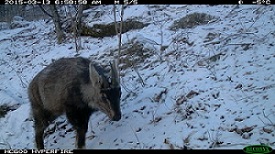Preserving the Fragile Future of Endangered Long-tailed Gorals
In the Republic of Korea, the long-tailed goral, a wild goat species, is listed as Endangered Species Class I by the Ministry of Environment and also as an intangible Natural Monument by the committee of heritage preservation. However, the survival of long-tailed gorals in Korea is threatened by habitat loss and the division of continuous habitats into smaller and smaller fragments. One of these threatened populations occurs in the Oseck-Kkeutchong sector in southern Seorak National Park, where the planned development of a cable-car for tourism jeopardizes their existence.

A long-tailed goral captured on a camera trap in South Korea; photo © Green Korea
The long-tailed goral, Naemorhedus caudatus, is found in the mountains of northern and eastern Asia, including Russia, China, part of the Himalayas and Korea. Brown fur with shades of gray and backward curving horns with a sharp end that form distinct rings characterizes the species. Gorals are herbivores, feeding on wide variety of grasses, woody materials, fruits and nuts. These endangered animals typically remain within a 1 km2 area to find the resources they need to survive. This home range is small for an animal of its body size, suggesting a reliance on specific habitats.
Cable-cars can be a popular tourist attraction and provide beautiful views and opportunities for wildlife viewing. However, cable-cars and the tourists they carry have been shown to have adverse impacts on similar mammal species in other parks. The Oseck-Kkeutchong cable-car is planned to cut through the habitat and breeding grounds of a wild goral population of about 30 individuals. Currently, a trail leads hikers away from optimal goral habitat while still allowing access. However, the proposed construction will fragment the small habitat, and increase human activity. These consequences are expected to have a negative impact on the long-tailed gorals, potentially driving the local extinction of the species.
Out of 13 goral populations along Baekdudaegan Mountain Range, only four harbor more than 100 individuals. Within the next few decades, nine populations, including the Seorak National Park population, are likely to go extinct unless habitat destruction is stopped and connections between currently fragmented populations are established. Therefore, the Korean Chapter of the Society for Conservation Biology strongly advocates against the planned construction of the cable-car within the Oseck-Kkeutchong sector in southern Seorak National Park. In a February 2017 letter, the Korean Chapter requested the Republic of Korea Minister of Environment, Cho Kyuengkyu, and the administrator of Cultural Heritage Administration, Rha Sun-Hwa, look for alternative plans that do not compromise the future of the fragile long-tailed gorals, and recommended the withdrawal of the cable-car project.